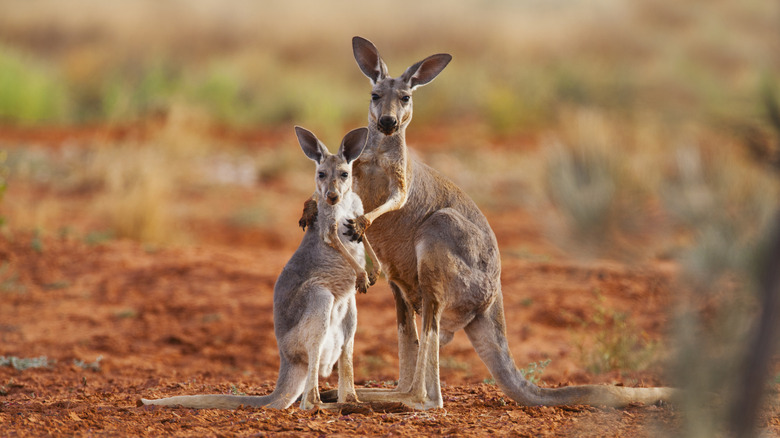What Is The Life Cycle Of A Kangaroo?
Kangaroos are members of the marsupial group of mammals, and they have many unique characteristics. They are exclusively herbivorous, and one of their defining features is the pouch in which they raise their young. The kangaroo life cycle starts with sexual reproduction, but after a brief gestation period, the embryo and the developing joey live in the mother's pouch. While mothers nurse their young as all mammals do, the kangaroo life cycle is quite different from that of common North American herbivorous mammals such as rabbits or deer.
Kangaroo reproduction and initial embryo development
Kangaroos reproduce sexually like other mammals and mate when the female kangaroo is fertile. The fertilized egg develops into a kangaroo embryo, but unlike other mammal embryos, the developing kangaroo does not embed itself in a placenta for long-term nourishment. Instead, the embryo lives off the contents of the yolk sac of the egg and uses up this source of food in about a month.
At this stage, the kangaroo embryo is still at a very early stage of development and is barely mobile. It is about 1 inch long, blind, hairless, and its rear legs are only stumps. When it is born, it uses its front legs to climb from the mother's birth canal through the thick fur up into the kangaroo pouch. Inside the pouch, it attaches itself to one of the teats that will be its source of food for the next six months or so.
Baby kangaroo and joey development
After about six months of living in the mother's pouch, the kangaroo embryo has grown rapidly and become a baby kangaroo, or joey. The joey is large enough to look out of the pouch, and it can start to exit the pouch to graze on its own. At the end of this period, the joey becomes more and more independent and spends longer periods outside the pouch. Especially at the beginning, it will still return to the pouch to sleep and feed, and when it senses danger.
After a further one and one half to two months, the joey is a mature kangaroo and leaves the pouch permanently to go off on its own. The mother is fertile as soon as the kangaroo embryo is born, but if an egg is fertilized when a joey is present in the pouch, development of the egg is usually delayed so that the mother normally has only one joey in her pouch.
Kangaroo lifespan and behavior
In the wild, mature kangaroos live six years on average, but they may live up to 20 years in captivity. Most kangaroos don't reach maturity due to a high mortality rate for embryos and baby kangaroos. Predators, dangerous especially for young kangaroos, include wild dogs, snakes, foxes, and eagles.
Kangaroos live in herds called mobs for mutual protection and defense. A mob of kangaroos will instinctively flee predators, but individuals may fight by kicking and biting when cornered. Although they have a different and unique life cycle, kangaroos are the dominant native mammal in Australia.
